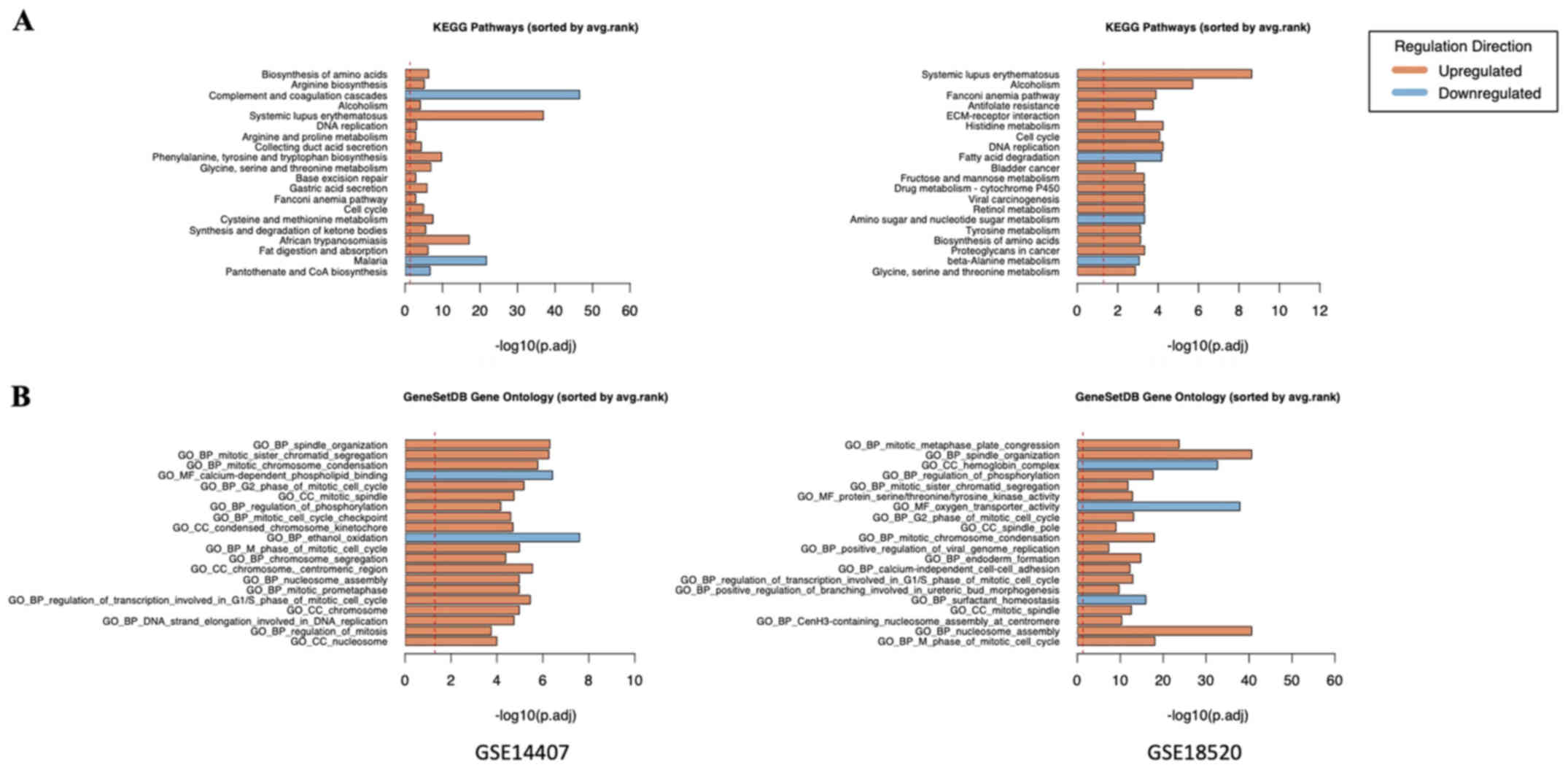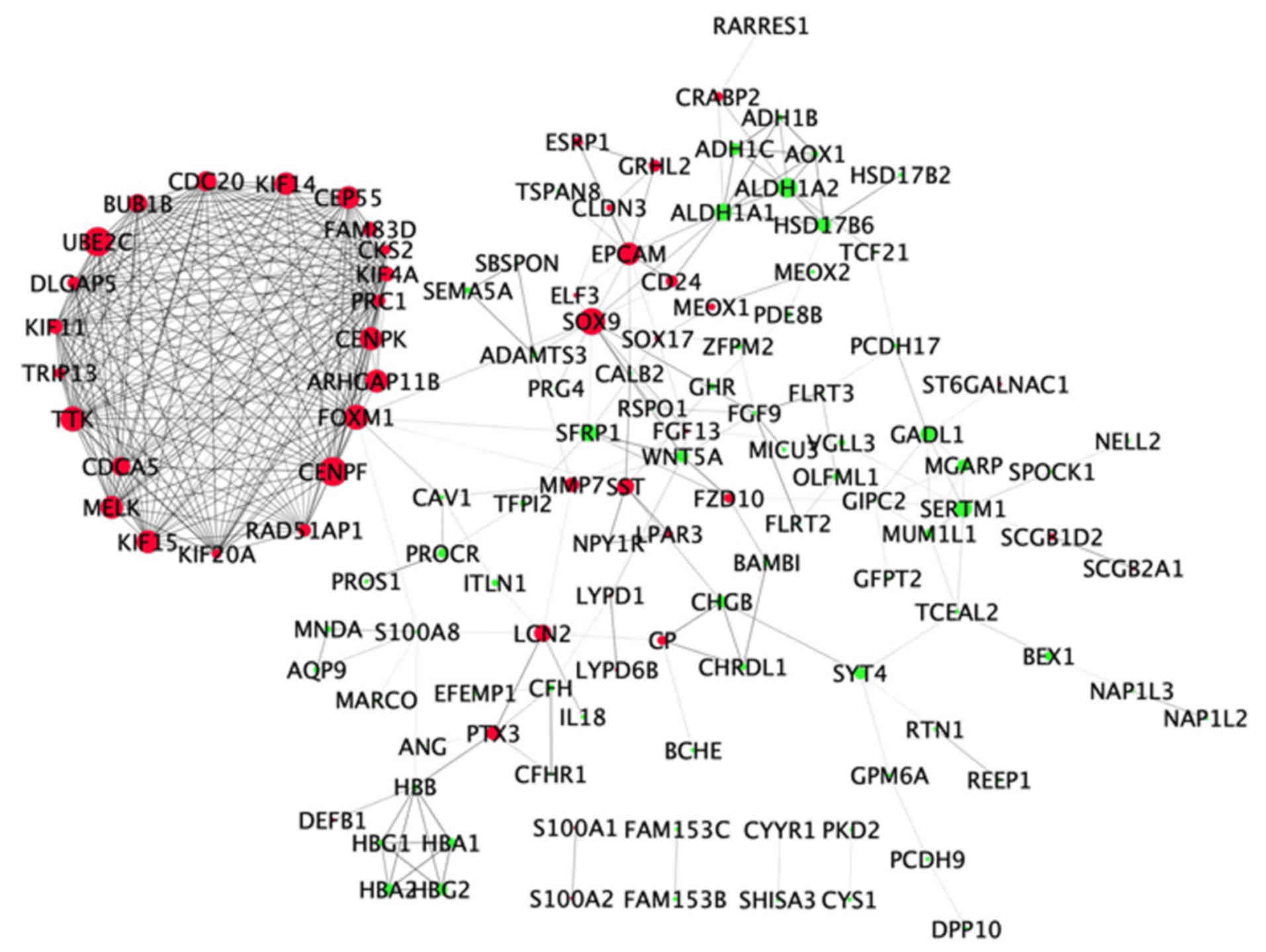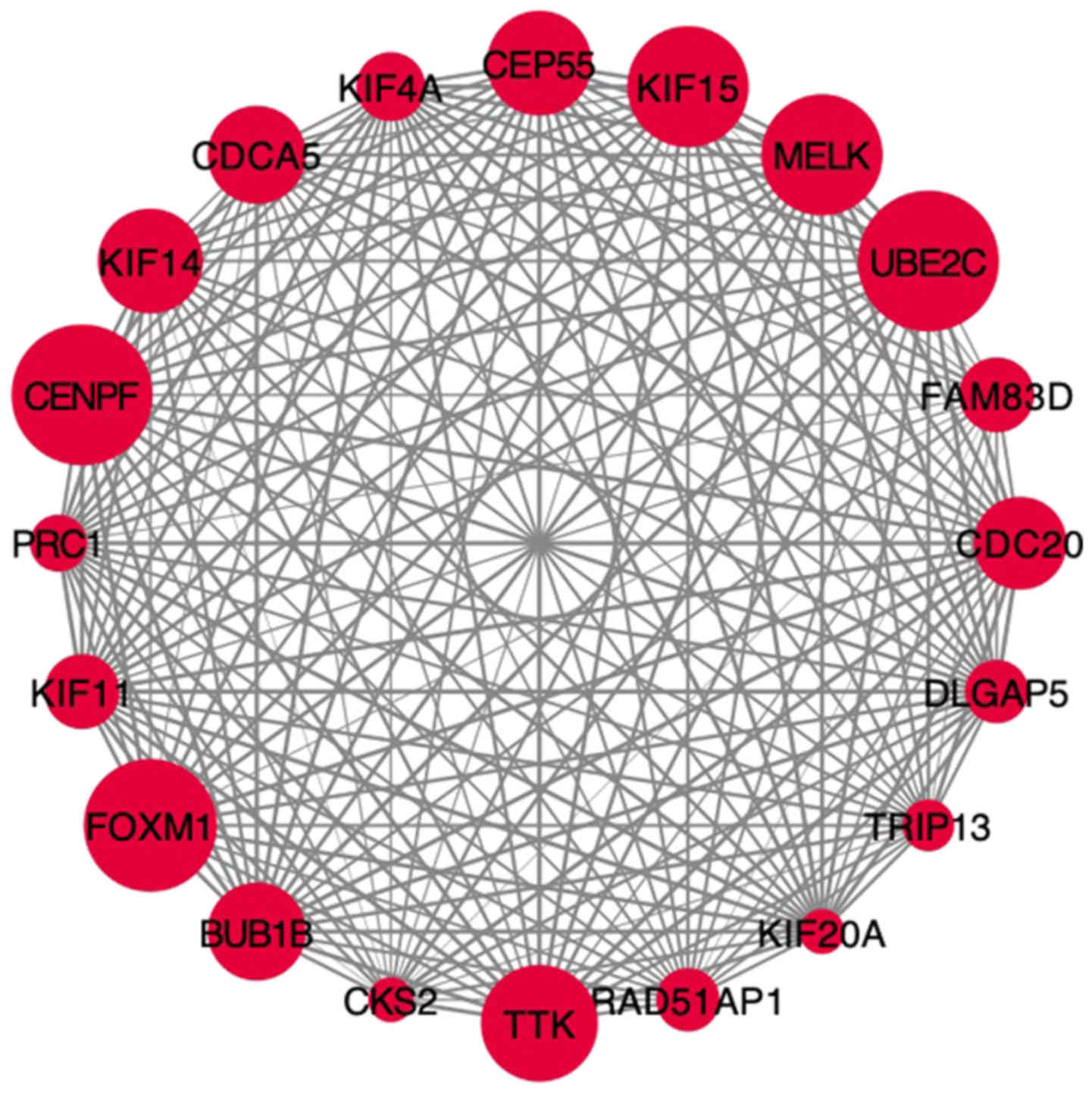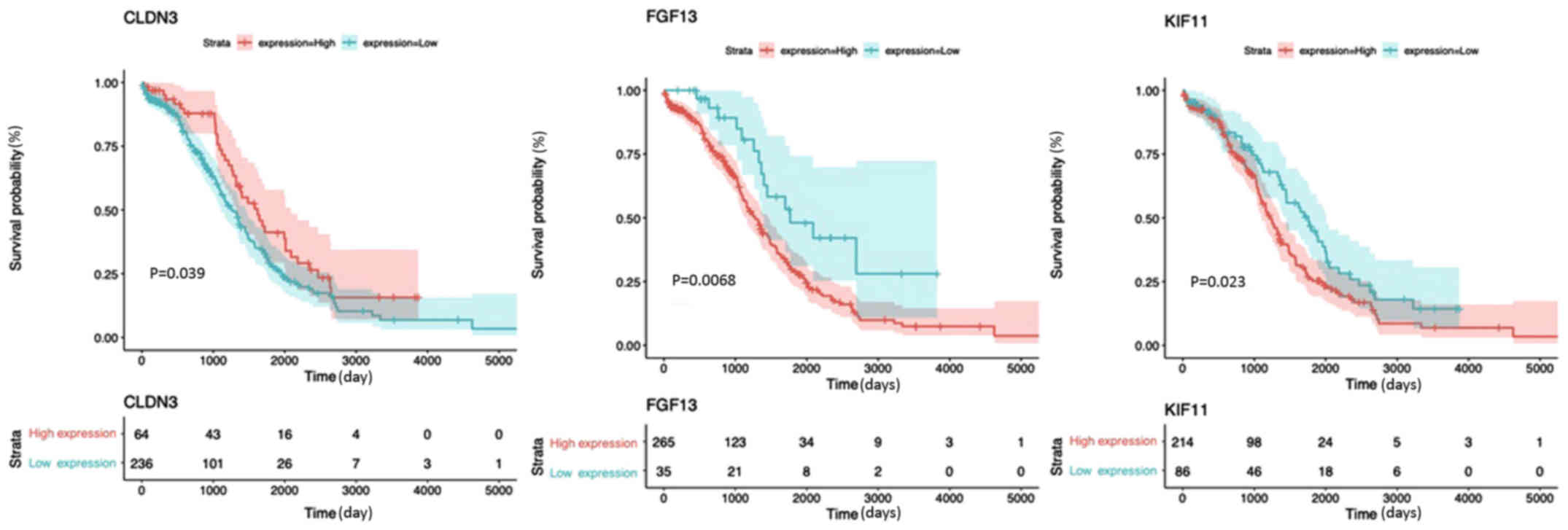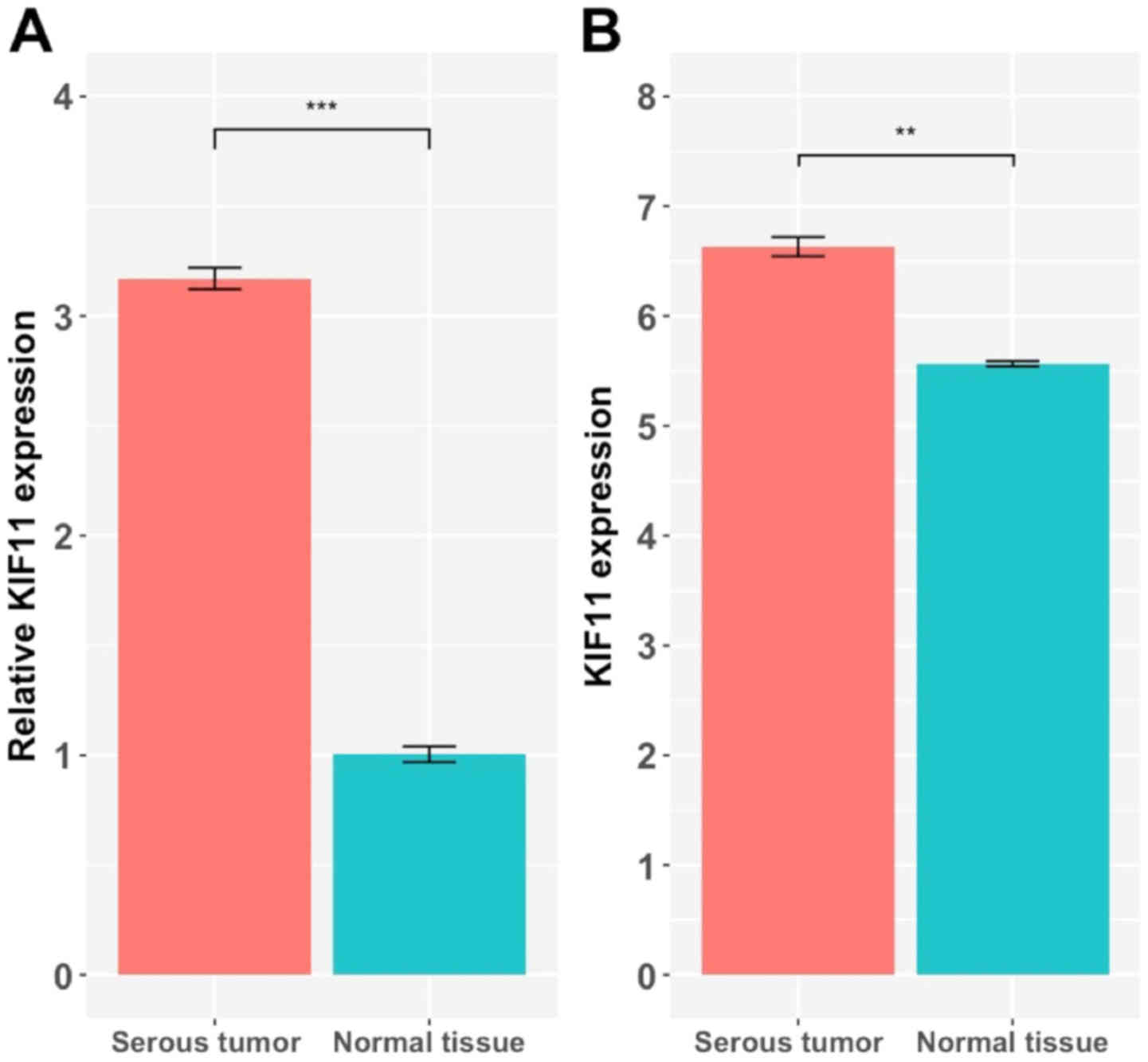|
1
|
Siegel R, Naishadham D and Jemal A: Cancer
statistics, 2013. CA Cancer J Clin. 63:11–30. 2013. View Article : Google Scholar : PubMed/NCBI
|
|
2
|
Wright JD, Shah M, Mathew L, Burke WM,
Culhane J, Goldman N, Schiff PB and Herzog TJ: Fertility
preservation in young women with epithelial ovarian cancer. Cancer.
115:4118–4126. 2009. View Article : Google Scholar : PubMed/NCBI
|
|
3
|
Jacobs I and Bast RC Jr: The CA 125
tumour-associated antigen: A review of the literature. Hum Reprod.
4:1–12. 1989. View Article : Google Scholar : PubMed/NCBI
|
|
4
|
Wei SU, Li H and Zhang B: The diagnostic
value of serum HE4 and CA-125 and ROMA index in ovarian cancer.
Biomed Rep. 5:41–44. 2016. View Article : Google Scholar : PubMed/NCBI
|
|
5
|
Ramalingam P: Morphologic,
immunophenotypic, and molecular features of epithelial ovarian
cancer. Oncology (Williston Park). 30:166–176. 2016.PubMed/NCBI
|
|
6
|
Gaitskell K, Green J, Pirie K, Barnes I,
Hermon C, Reeves GK and Beral V; Million Women Study Collaborators,
: Histological subtypes of ovarian cancer associated with parity
and breastfeeding in the prospective Million Women Study. Int J
Cancer. 142:281–289. 2018. View Article : Google Scholar : PubMed/NCBI
|
|
7
|
Bassis ML: An embryologically derived
classification of ovarian tumors. JAMA. 174:1316–1319. 1960.
View Article : Google Scholar : PubMed/NCBI
|
|
8
|
Sun YV and Hu YJ: Integrative analysis of
multi-omics data for discovery and functional studies of complex
human diseases. Adv Genet. 93:147–190. 2016. View Article : Google Scholar : PubMed/NCBI
|
|
9
|
Mok SC, Bonome T, Vathipadiekal V, Bell A,
Johnson ME, Wong KK, Park DC, Hao K, Yip DK, Donninger H, et al: A
gene signature predictive for outcome in advanced ovarian cancer
identifies a survival factor: Microfibril-associated glycoprotein
2. Cancer Cell. 16:521–532. 2009. View Article : Google Scholar : PubMed/NCBI
|
|
10
|
Bowen NJ, Walker LD, Matyunina LV, Logani
S, Totten KA, Benigno BB and McDonald JF: Gene expression profiling
supports the hypothesis that human ovarian surface epithelia are
multipotent and capable of serving as ovarian cancer initiating
cells. BMC Med Genomics. 2:712009. View Article : Google Scholar : PubMed/NCBI
|
|
11
|
Yoshihara K, Tajima A, Komata D, Yamamoto
T, Kodama S, Fujiwara H, Suzuki M, Onishi Y, Hatae M, Sueyoshi K,
et al: Gene expression profiling of advanced-stage serous ovarian
cancers distinguishes novel subclasses and implicates ZEB2 in tumor
progression and prognosis. Cancer Sci. 100:1421–1428. 2009.
View Article : Google Scholar : PubMed/NCBI
|
|
12
|
Alhamdoosh M, Ng M, Wilson NJ, Sheridan
JM, Huynh H, Wilson MJ and Ritchie ME: Combining multiple tools
outperforms individual methods in gene set enrichment analyses.
Bioinformatics. 33:414–424. 2017.PubMed/NCBI
|
|
13
|
Colaprico A, Silva TC, Olsen C, Garofano
L, Cava C, Garolini D, Sabedot TS, Malta TM, Pagnotta SM,
Castiglioni I, et al: TCGAbiolinks: An R/Bioconductor package for
integrative analysis of TCGA data. Nucleic Acids Res. 44:e712016.
View Article : Google Scholar : PubMed/NCBI
|
|
14
|
Shimizu Y, Kamoi S, Amada S, Hasumi K,
Akiyama F and Silverberg SG: Toward the development of a universal
grading system for ovarian epithelial carcinoma. I. Prognostic
significance of histopathologic features--problems involved in the
architectural grading system. Gynecol Oncol. 70:2–12. 1998.
View Article : Google Scholar : PubMed/NCBI
|
|
15
|
Wright JD, Matsuo K, Huang Y, Tergas AI,
Hou JY, Khoury-Collado F, St Clair CM, Ananth CV, Neugut AI and
Hershman DL: Prognostic performance of the 2018 international
federation of gynecology and obstetrics cervical cancer staging
guidelines. Obstet Gynecol. 134:49–57. 2019. View Article : Google Scholar : PubMed/NCBI
|
|
16
|
Mazzei M, Vascellari M, Zanardello C,
Melchiotti E, Vannini S, Forzan M, Marchetti V, Albanese F and
Abramo F: Quantitative real time polymerase chain reaction
(qRT-PCR) and RNAscope in situ hybridization (RNA-ISH) as effective
tools to diagnose feline herpesvirus-1-associated dermatitis. Vet
Dermatol. 30:491–e147. 2019. View Article : Google Scholar : PubMed/NCBI
|
|
17
|
R Core Team: R: A language and environment
for statistical computing. R Foundation for Statistical Computing;
Vienna: 2014, PubMed/NCBI
|
|
18
|
Gentleman RC, Carey VJ, Bates DM, Bolstad
B, Dettling M, Dudoit S, Ellis B, Gautier L, Ge Y, Gentry J, et al:
Bioconductor: Open software development for computational biology
and bioinformatics. Genome Biol. 5:R802004. View Article : Google Scholar : PubMed/NCBI
|
|
19
|
Sobin LH and Wittekind C: TNM
Classification of Malignant Tumours. Union for International Cancer
Control (UICC). John Wiley & Sons; Oxford: 2009
|
|
20
|
Dorsett KA, Jones RB, Ankenbauer KE,
Hjelmeland AB and Bellis SL: Sox2 promotes expression of the
ST6Gal-I glycosyltransferase in ovarian cancer cells. J Ovarian
Res. 12:932019. View Article : Google Scholar : PubMed/NCBI
|
|
21
|
Ma L, Zhang JH, Liu FR and Zhang X:
Hypermethylation of promoter region of RASSF1A gene in ovarian
malignant epithelial tumors. Zhonghua Zhong Liu Za Zhi. 27:657–659.
2005.(In Chinese). PubMed/NCBI
|
|
22
|
Blangy A, Lane HA, d'Hérin P, Harper M,
Kress M and Nigg EA: Phosphorylation by p34cdc2 regulates spindle
association of human Eg5, a kinesin-related motor essential for
bipolar spindle formation in vivo. Cell. 83:1159–1169. 1995.
View Article : Google Scholar : PubMed/NCBI
|
|
23
|
Martens-de Kemp SR, Nagel R, Stigter-van
Walsum M, van der Meulen IH, van Beusechem VW, Braakhuis BJ and
Brakenhoff RH: Functional genetic screens identify genes essential
for tumor cell survival in head and neck and lung cancer. Clin
Cancer Res. 19:1994–2003. 2013. View Article : Google Scholar : PubMed/NCBI
|
|
24
|
Venere M, Horbinski C, Crish JF, Jin X,
Vasanji A, Major J, Burrows AC, Chang C, Prokop J, Wu Q, et al: The
mitotic kinesin KIF11 is a driver of invasion, proliferation, and
self-renewal in glioblastoma. Sci Transl Med. 7:304ra1432015.
View Article : Google Scholar : PubMed/NCBI
|
|
25
|
Imai T, Oue N, Sentani K, Sakamoto N,
Uraoka N, Egi H, Hinoi T, Ohdan H, Yoshida K and Yasui W: KIF11 is
required for spheroid formation by oesophageal and colorectal
cancer cells. Anticancer Res. 37:47–55. 2017. View Article : Google Scholar : PubMed/NCBI
|
|
26
|
Daigo K, Takano A, Thang PM, Yoshitake Y,
Shinohara M, Tohnai I, Murakami Y, Maegawa J and Daigo Y:
Characterization of KIF11 as a novel prognostic biomarker and
therapeutic target for oral cancer. Int J Oncol. 52:155–165.
2018.PubMed/NCBI
|
|
27
|
Zhao WM, Seki A and Fang G: Cep55, a
microtubule-bundling protein, associates with centralspindlin to
control the midbody integrity and cell abscission during
cytokinesis. Mol Biol Cell. 17:3881–3896. 2006. View Article : Google Scholar : PubMed/NCBI
|
|
28
|
Wang Y, Jin T, Dai X and Xu J:
Lentivirus-mediated knockdown of CEP55 suppresses cell
proliferation of breast cancer cells. Biosci Trends. 10:67–73.
2016. View Article : Google Scholar : PubMed/NCBI
|
|
29
|
Zhang W, Niu C, He W, Hou T, Sun X, Xu L
and Zhang Y: Upregulation of centrosomal protein 55 is associated
with unfavorable prognosis and tumor invasion in epithelial ovarian
carcinoma. Tumour Biol. 37:6239–6254. 2016. View Article : Google Scholar : PubMed/NCBI
|
|
30
|
Kurita K, Maeda M, Mansour MA, Kokuryo T,
Uehara K, Yokoyama Y, Nagino M, Hamaguchi M and Senga T: TRIP13 is
expressed in colorectal cancer and promotes cancer cell invasion.
Oncol Lett. 12:5240–5246. 2016. View Article : Google Scholar : PubMed/NCBI
|
|
31
|
Chudasama D, Bo V, Hall M, Anikin V,
Jeyaneethi J, Gregory J, Pados G, Tucker A, Harvey A, Pink R, et
al: Identification of cancer biomarkers of prognostic value using
specific gene regulatory networks (GRN): A novel role of RAD51AP1
for ovarian and lung cancers. Carcinogenesis. 39:407–417. 2018.
View Article : Google Scholar : PubMed/NCBI
|
|
32
|
Roy D, Sheng GY, Herve S, Carvalho E,
Mahanty A, Yuan S and Sun L: Interplay between cancer cell cycle
and metabolism: Challenges, targets and therapeutic opportunities.
Biomed Pharmacother. 89:288–296. 2017. View Article : Google Scholar : PubMed/NCBI
|
|
33
|
Parker AL, Kavallaris M and McCarroll JA:
Microtubules and their role in cellular stress in cancer. Front
Oncol. 4:1532014. View Article : Google Scholar : PubMed/NCBI
|
|
34
|
Turner N and Grose R: Fibroblast growth
factor signalling: From development to cancer. Nat Rev Cancer.
10:116–129. 2010. View
Article : Google Scholar : PubMed/NCBI
|
|
35
|
Okada T, Murata K, Hirose R, Matsuda C,
Komatsu T, Ikekita M, Nakawatari M, Nakayama F, Wakatsuki M, Ohno
T, et al: Upregulated expression of FGF13/FHF2 mediates resistance
to platinum drugs in cervical cancer cells. Sci Rep. 3:28992013.
View Article : Google Scholar : PubMed/NCBI
|
|
36
|
Yu L, Toriseva M, Tuomala M, Seikkula H,
Elo T, Tuomela J, Kallajoki M, Mirtti T, Taimen P, Boström PJ, et
al: Increased expression of fibroblast growth factor 13 in prostate
cancer is associated with shortened time to biochemical recurrence
after radical prostatectomy. Int J Cancer. 139:140–152. 2016.
View Article : Google Scholar : PubMed/NCBI
|
|
37
|
Bublik DR, Bursać S, Sheffer M, Oršolić I,
Shalit T, Tarcic O, Kotler E, Mouhadeb O, Hoffman Y, Fuchs G, et
al: Regulatory module involving FGF13, miR-504, and p53 regulates
ribosomal biogenesis and supports cancer cell survival. Proc Natl
Acad Sci USA. 114:E496–E505. 2017. View Article : Google Scholar : PubMed/NCBI
|
|
38
|
Shang X, Lin X, Alvarez E, Manorek G and
Howell SB: Tight junction proteins claudin-3 and claudin-4 control
tumor growth and metastases. Neoplasia. 14:974–985. 2012.
View Article : Google Scholar : PubMed/NCBI
|
|
39
|
Jääskeläinen A, Soini Y, Jukkola-Vuorinen
A, Auvinen P, Haapasaari KM and Karihtala P: High-level cytoplasmic
claudin 3 expression is an independent predictor of poor survival
in triple-negative breast cancer. BMC Cancer. 18:2232018.
View Article : Google Scholar : PubMed/NCBI
|
|
40
|
Ferrer-Torres D, Nancarrow DJ, Kuick R,
Thomas DG, Nadal E, Lin J, Chang AC, Reddy RM, Orringer MB, Taylor
JM, et al: Genomic similarity between gastroesophageal junction and
esophageal Barrett's adenocarcinomas. Oncotarget. 7:54867–54882.
2016. View Article : Google Scholar : PubMed/NCBI
|
|
41
|
Che J, Yue D, Zhang B, Zhang H, Huo Y, Gao
L, Zhen H, Yang Y and Cao B: Claudin-3 inhibits lung squamous cell
carcinoma cell epithelial-mesenchymal transition and invasion via
suppression of the Wnt/β-catenin signaling pathway. Int J Med Sci.
15:339–351. 2018. View Article : Google Scholar : PubMed/NCBI
|
|
42
|
Ahmad R, Kumar B, Chen Z, Chen X, Müller
D, Lele SM, Washington MK, Batra SK, Dhawan P and Singh AB: Loss of
claudin-3 expression induces IL6/gp130/Stat3 signaling to promote
colon cancer malignancy by hyperactivating Wnt/β-catenin signaling.
Oncogene. 36:6592–6604. 2017. View Article : Google Scholar : PubMed/NCBI
|
|
43
|
Schneider MA, Christopoulos P, Muley T,
Warth A, Klingmueller U, Thomas M, Herth FJ, Dienemann H, Mueller
NS, Theis F, et al: AURKA, DLGAP5, TPX2, KIF11 and CKAP5: Five
specific mitosis-associated genes correlate with poor prognosis for
non-small cell lung cancer patients. Int J Oncol. 50:365–372. 2017.
View Article : Google Scholar : PubMed/NCBI
|
|
44
|
Xu Z, Zhou Y, Cao Y, Dinh TLA, Wan J and
Zhao M: Identification of candidate biomarkers and analysis of
prognostic values in ovarian cancer by integrated bioinformatics
analysis. Med Oncol. 33:1302016. View Article : Google Scholar : PubMed/NCBI
|
|
45
|
Guo Q, He Y, Sun L, Kong C, Cheng Y, Wang
P and Zhang G: Identification of potential prognostic TF-associated
lncRNAs for predicting survival in ovarian cancer. J Cell Mol Med.
23:1840–1851. 2019.PubMed/NCBI
|
|
46
|
Reese SE, Archer KJ, Therneau TM, Atkinson
EJ, Vachon CM, de Andrade M, Kocher JP and Eckel-Passow JE: A new
statistic for identifying batch effects in high-throughput genomic
data that uses guided principal component analysis. Bioinformatics.
29:2877–2883. 2013. View Article : Google Scholar : PubMed/NCBI
|
|
47
|
Danielsson F, James T, Gomez-Cabrero D and
Huss M: Assessing the consistency of public human tissue RNA-seq
data sets. Brief Bioinform. 16:941–949. 2015. View Article : Google Scholar : PubMed/NCBI
|















